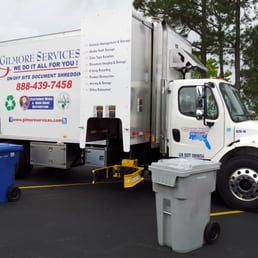Internal Data Destruction Risks vs Benefits
Tue, Oct 29, 2019
By: Jim Beran

Is your business bound by HIPAA, FACTA or Sarbanes-Oxley regulations? If so, then you have a legal responsibility to maintain accurate records and destroy them according to the timetables specified by the law.
It’s common for small businesses to try to save money by relying on internal data destruction. One of the most common questions we hear at Gilmore Services is this:
What are the benefits of onsite certified data destruction?
We like getting that question because it gives us a chance to explain why internal data destruction is so risky, and why it’s a worthwhile investment to hire a specialist like Gilmore Services to do onsite certified data destruction.
The Risks of Internal Data Destruction
Internal data destruction is rarely as effective as people think it is. It’s common for companies to use one of these methods to destroy data, assuming that they’re protected. Unfortunately, these methods all run the risk of leaving your data vulnerable:
- Computer hard drive destruction using hammers, bullets, or other items to smash or mutilate the hard drive. The problem with these methods is that, while they might be fun, they’re rarely effective.
- Degaussing uses strong magnets to render a hard drive inoperable. That might sound good, but it makes it impossible to tell whether the data has been eradicated – leaving your data vulnerable.
There are also environmental risks associated with destroying data internally. Computer hard drives contain potentially harmful metals. Since some of the materials in your hard drives may be classified as hazardous materials, you’ll need to comply with RCRA regulations. Failure to do so could result in environmental damage, employee health issues and a hefty fine.
The Benefits of Onsite Certified Data Destruction
The best option is to partner with a NAID-certified data destruction specialist like Gilmore Services to ensure that your data is properly destroyed in accordance with all federal and state guidelines. To become NAID certified, companies must:
- Submit to an in-depth, three-level background screening process.
- Adhere to strict protocols to keep your data secure during the destruction process.
- Adhere to all regulatory requirements, including HIPAA, FACTA, Sarbanes-Oxley and the RCRA.
- Submit to unannounced audits to ensure compliance.
Having a NAID-certified destruction company will minimize your risks. Here are some of the benefits of onsite certified data destruction:
- Your clients’ data will be secure at all times. A data destruction specialist will keep your data secure at every stage of the destruction process. You can rest easy knowing that your clients’ data won’t be at risk of compromise.
- Access to your data will be limited to authorized personnel only. As we said above, NAID certification requires all employees to undergo a detailed background check. You can be confident that no unauthorized person will be able to get to your data before it is destroyed.
- You’ll receive a certificate confirming the destruction of your data.
The bottom line is that paying for onsite certified data destruction will give the peace of mind of knowing that your data is protected and properly destroyed.
Conclusion
While it might be tempting to destroy your data internally, the risks of doing that are high and could be devastating to your business. Your best option is to pay for onsite certified data destruction.
Are you searching for an onsite certified data destruction specialist to destroy your sensitive data? Click here to learn how Gilmore Services can help.
